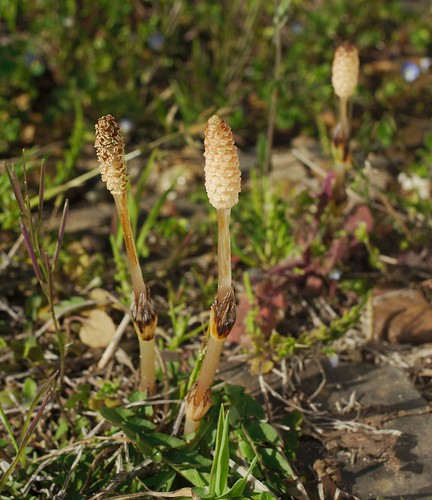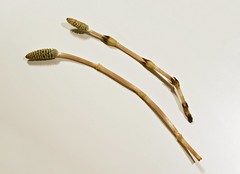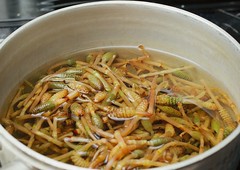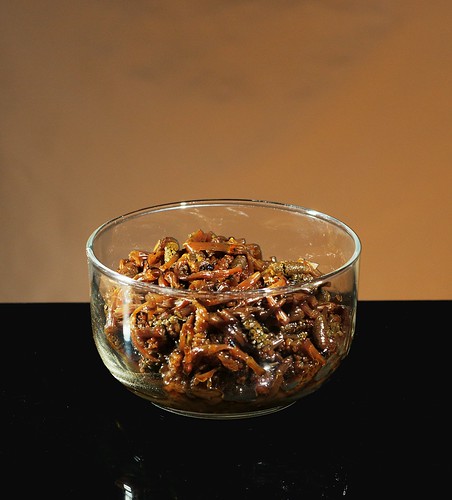"土筆" (tsukushi), called "horsetail" in english, is a fairly common wild plant - weed - in Japan. They'll grow in ditches, on the edges of ricefields and on overgrown and disused plots. In spring it grows thick spore stalks that kind of resemble colorless asparagus. And as it happens, they are not only edible, but Ritsuko has a great recipe for tsukushi rice topping too.
The stalks show up towards the end of March so they are a great excuse for us to go outside and enjoy spring for a day. Unlike the cherry blossoms, this is a spring ritual we can enjoy quietly, without braving huge, drunken crowds (not that there's anything wrong with that; I enjoy being a huge, drunken crowd as much as anyone). This is the third year in a row we've gone to Seika in southern Kyoto (that's where I currently work) to spend the day searching for the plant among the rice fields and ditches of the area. One tip is to go earlier rather than later; while they're harder to find early in the season, the smaller stalks are firmer and more flavourful. It makes for a better dish.
Cooking tsukushi could not be easier. Surprisingly often Japanese cooking is based on boiling, sautéeing or dipping your ingredients in a salty, sweet and savoury sauce. It can be thick or thin, and made by some combination of soy sauce, mirin, sake, rice vinegar or dashi. This kind of sauce or soup forms the base of a surprising number of dishes (I'd say almost all of them to some degree). We'll treat the tsukushi in the same way.
First, the only really tedious job: clean the tsukushi. Each stalk has a number of dry collars. These need to go. With a little practice you can use the thumbnail of one hand to sort of scrape it off while you rotate the stalk with the other hand. It's still a pain though.
Once they've cleaned, you put them in a large pot and simmer for, oh, 10-15 minutes or so. Strain, put in a smaller pot, then add soy sauce, sake, sugar and dashi. How much? "適当に" - "appropriate" according to our in-house expert. So now you know. Simmer in the soup for a little while, adjusting the taste as needed (how? You gessed it: 適当に) then put on a lid, turn off the heat and let it slowly cool for the next hour or so.
You end up with dark red-brown, slightly sticky stalks with an amazing flavour that you eat by simply adding it over your rice. Keeps for weeks in the refridgerator too. And you can of course treat many other vegetables the same way; just remember that it has to be a reasonably firm plant that can take the longish cooking time.





thanks for the tip! lately, i have been noticing these small plants and my gf is very excited about them. however, she didn't know that she could eat one of her favorite springtime plants. i found your blog through your picture of the ramen museum in osaka and have been following it since. great pictures and great commentary on life in another country.
ReplyDeleteAh... this was just what I was after: A salaryman gave us a bunch of Tsukushi on friday night and I did not want them to go to waste. I now have an apartment full of the sweet scent of simmering cooking Sake, Soy Sauce and Tsukushi... quite a heady mix actually. Thanks and I agree wholeheartedly with your more recent comments on the two useless-party political system. Let us hope it gives rise to something positive within the rest of the political spectrum.
ReplyDelete